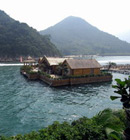Society
Mao statues fashionable again after four decades
By Wen Chihua (China Features)
Updated: 2010-01-18 08:22
 |
Large Medium Small |
Many Mao Zedong statues were erected across the nation during the "cultural revolution"(1966-76). Most were destroyed but some still survive and are now seen as "works of art".

Workers clean up the stone statue of former chairman Mao Zedong in Zhijingshan Square, Zhenzhou. [Chen Xiaodong/China Daily] |
The white marble statue of former chairman Mao Zedong in Hongguang Square, Hongguang township, Sichuan province, shows a sagacious, strong, middle-aged man, in an unbuttoned overcoat, flanked by three people. His gaze focused on the future.
"It was erected by the township government on March 16, 1995 to mark Mao's visit in 1958," says a local government official.
On this day every year, the government organizes the "3.16 (March 16) Jubilee". Many people come to burn incense in front of the statue, and to pray for prosperity and good luck.
Trimming evergreen trees in the courtyard of the township government building, a gardener in his 50s who uses just his surname, Yi, says that for many locals, government officials and ordinary people, Mao is someone "you feel both indebted to and dislike at the same time".
"When I see senior officials today acting like the people's masters instead of their servants, I miss Mao," Yi says.
Yi was at school the day Mao came visiting, half a century ago. "My mother told me later that she and other commune members were harvesting hemp, when they saw a sedan stop on the path meant for tractors. A large man wearing a gray, Sun Yat-sen style tunic, got out of the car and walked into the fields. It was Mao. He chatted with the villagers like they were family members. He was not at all pretentious," Yi says.
The town in Pixian county was called Hexing - Everything Flourishes - at the time. After Mao's visit, it was changed to Hongguang - Red Glow. Everything Mao touched, or saw, was given the name Xingfu or Yingfu, both meaning "blessed".
Wang Youxing, 67, does not think of himself as blessed, although he has a porcelain bust of Mao set in the alcove above the square table in his central room, where traditionally Chinese families keep a statue of the god of fortune.
"The old man's economic policy, such as the Great Leap Forward, was just too Left. You worked very hard in the field all year around, and hardly had enough to eat. Always being hungry is scary. People cannot understand just how scary it is unless they experience it," Huang says. His family of seven now lives a comfortable life, running a nursery.
The Great Leap Forward (1958-63) aimed at rapidly transforming China from an agrarian economy into a modern communist society. Many communes quickly reported record high yields of grain. These records were spoken of as "rockets shooting into the sky". Pixian county, 20 km west of Chengdu, was the first of its kind in Sichuan to report a yield of 50,000 kg per 0.067 hectare. The campaign eventually came to an end after a chain of catastrophes that brought about a famine that claimed the lives of tens of millions of people throughout the country.
|
 |
In 1966, the Red Guards of Tsinghua University in Beijing demolished the Qinghua Yuan archway on campus, denouncing it as a symbol of the three evils - feudalism, capitalism, and revisionism. The archway had been part of the Imperial Gardens of the Qing Dynasty (1644-1911). A year later, a statue of Mao, designed by Tsinghua's architecture department, appeared on the site of the archway.
The giant memorial, 8-m-tall, was the first statue that showed Mao wearing a military cap and overcoat, with the right arm raised. His raised right arm was meant to suggest, "Mao waves, I advance". A verse by Lin Biao, Mao's comrade-in-arms and designated successor, was inscribed on the pedestal of the monument. It read:
May Great Mentor,
Great Leader,
Great Commander,
Great Helmsman,
Chairman Mao Live for a thousand years.














